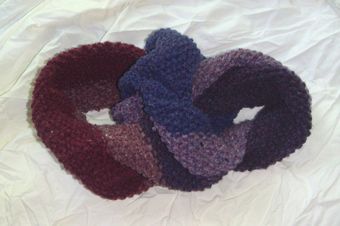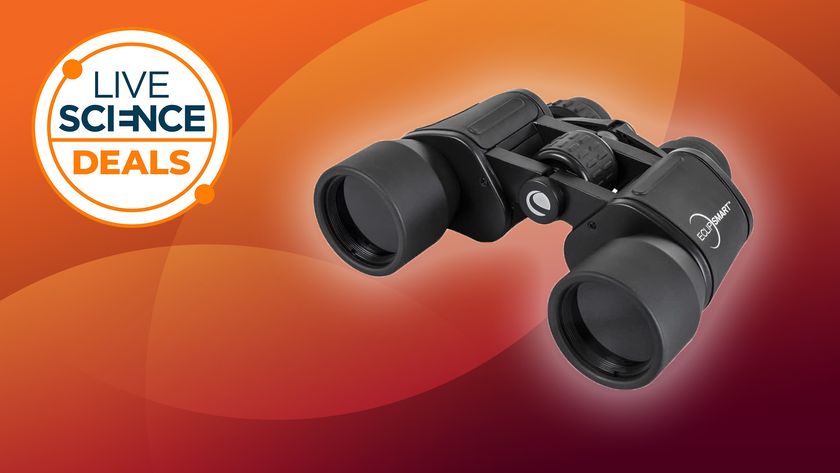New Math Tricks: Knitting and Crocheting

Coral reefs can be crocheted. The atmosphere can be knit. And a stop sign can be folded into a pair of pants.
Welcome to the intersection of math and handicraft. Unexpectedly, handicraft in general, and yarn work in particular, has started to help provide answers to a wide range of mathematical problems. From the way the atmosphere generates weather to the shape of the human brain, knit and crocheted models have provided new insight into the geometry of the natural world.
"Crochet, knitting and other crafts allow people to visualize, recontextualize and develop new problems and answers," said Carolyn Yackel, a mathematician at Mercer University in Georgia.
Another prominent practitioner who uses yarn work, mathematician Hinke Osinga of the University of Bristol, puts it this way: "You can get bogged down in your own standard techniques of doing things, and then someone asks a silly question, and all of a sudden, you see a new way of interpreting things."
The math of handicraft was long dismissed as merely a cute trick or an inconsequential coincidence. Now, however, handicraft has begun to come into its own as a legitimate tool for mathematical research. This is especially true of knitting and crochet, which, thanks to the efforts of a new group of researchers, are now receiving a great deal of attention from the world of theoretical mathematics. Yackel and Osinga, along with Sarah-Marie Belcastro of Smith College and Daina Taimina of Cornell University, form the core of the group looking at the intersection of math and craft. Some of them are using craft to help answer math problems, while others are using math to answer knitting problems.
In 2005, there was a special session on math and the fiber arts during a joint meeting of the American Mathematical Society and the Mathematical Association of America. This conference, along with a newly released book based on the special session by its organizers, represents the newest expressions of a very old topic.
It is believed that the partnership between math and craft dates back to the invention of geometry, where the repetitive patterns seen in ancient baskets and weavings first hinted at a mathematical subtext to the world at large. Later, Alan Turing, the theorist and computer scientist, was often seen knitting Möbius strips and other geometric shapes during his lunch break.
Sign up for the Live Science daily newsletter now
Get the world’s most fascinating discoveries delivered straight to your inbox.
The modern interest in math and craft began in 1997 when Taimina devised a plan for crocheting a hyperbolic plane. Hyperbolic planes are spaces of negative curvature (imagine the shape of a riding saddle) where all lines curve away from each other. Hyperbolic planes are fairly common in nature, appearing everywhere from the frills on a sea slug to growth patterns of coral to the way the brain folds.
The craft objects themselves tend to be common shapes, such as discs, spheres and cones. However, just as a triangle that normally only has 180-degrees worth of angles can have three 90-degree angles when drawn on a sphere, the shapes take on novel and surprising forms when projected across hyperbolic space.
Despite being widespread in nature and well understood in theoretical math, no good physical models of a hyperbolic shape existed until Taimina crocheted her first plane. In hyperbolic space, points move away from each other as the shape expands. While it is hard to model this using paper or plastic, it is easily replicated by simply increasing the number of stitches per row as the shape is knit or crocheted.
“What you can do is get a tactile insight. I theoretically understand the concept, but [the model] allows me to communicate it,” said Taimina.
After Taimina’s crocheted models gained a degree of notoriety, Hinke Osinga realized that if a hyperbolic plane could be modeled with crochet, then a model of the complex shape her research focused on could be made the same way. Osinga was looking at the Lorenz manifold, another shape that had yet to be presented in a physical model. Manifolds are shapes where the curved nature of the larger shape can be treated as a flat plane over short distances, like a 2-D road map sufficiently representing a portion of the 3-D Earth.
The Lorenz manifold models how objects move through a chaotic space such as a flowing river or the atmosphere. Various applications include meteorological prediction and spacecraft navigation. Before Osinga made her crochet Lorenz manifold, there had never been a physical model of this shape for reference.
Around the same time that Osinga was using craft to answer questions about math, Yackel and Belcastro began their attempt to answer questions raised by craft with math.
Belcastro designed a mathematical proof detailing why any topological surface can be knit. While seemingly limited to explaining yarn work, the proof could have ramifications for biology. A range of phenomena from shell growth to bird’s nest-building replicate knitting by building up a structure one line at a time.
For Yackel, the research involved moving beyond knitting. Instead, she began using Japanese string balls called temari as the basis for designing a way to map out points on a sphere. Temari balls are decorative items made from colored strings wrapped around a small wooden or plastic sphere.
As the strings crisscross the surface of the sphere, they form intricate patterns. To approximate points on the sphere, temari artists use origami techniques that are actually just physical representations of very complex geometry.
Together, Yackel and Belcastro have co-edited a new book "Making Mathematics with Needlework: Ten Papers and Ten Projects." In it, they use the knitting of a baby’s pants to show how, in certain types of mathematics, an octagon can be folded into a two-holed donut. Using their math, if one crocheted a stop sign, it could be folded into a pair of pants.
For all of the researchers involved in this field, pursuing the link between everyday objects and complex math hearkens back to the original impetus for devising geometry in the first place.
"We talk about the different experiences that lead people to geometry, and it began with making patterns," said Taimina. "How do you learn that something is round?"
- Video: Make Origami Paper Stars
- Top 10 Unexplained Phenomena
- Gallery — Colorful Creations: Incredible Coral
This story is provided by Scienceline, a project of New York University's Science, Health and Environmental Reporting Program.

We rate these as some of the best solar binoculars around — order them now just in time for the partial eclipse on March 29 and save 33%

'Extremely Large Telescope' being built in Chile could detect signs of alien life in a single night

Ancient Egyptian pyramids, thought to contain only the elite, may also hold low-class laborers







